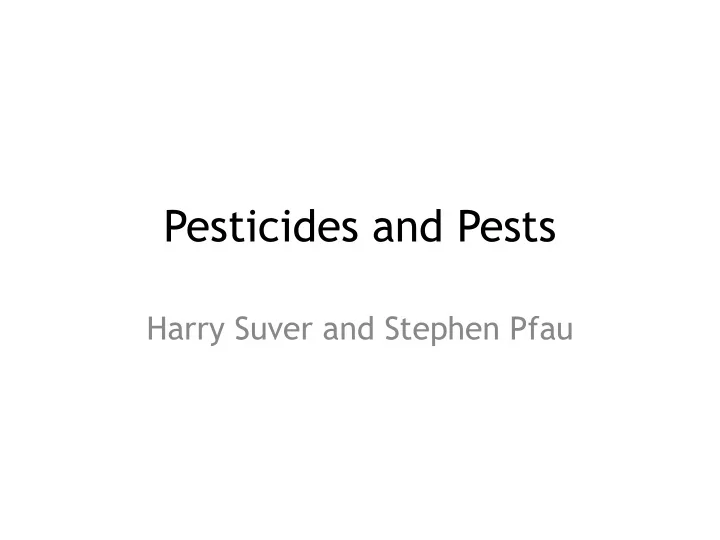

Pesticides and Pests Harry Suver and Stephen Pfau
What is a Pest? • Pests are insects, animals, or any other organism that is harmful to humans, crops, or livestock. • Pests have a huge impact on agriculture and can have a great impact on our economy. • Pests reduce crop yields and have caused major problems for farmers for centuries. • Aphids, larvae, crickets, and grasshoppers all damage crops while insects such as termites and wood ants can cause structural damage. • Pests have been one of the biggest effects on our economy and lifestyle for hundreds of years.
Pesticides • Pesticides were how humans answered to the problem of pests. • They are substances used for destroying or mitigating any pest that presents a problem to human interests. • Pesticides are most commonly biological or chemical agents, and their main purpose is to protect crop yields. • There are dozens of different pesticides which include algaecides, biocides, fungicides, rodenticides, insecticides, herbicides, etc. • Some active ingredients in pesticides: zinc sulfate, chromium, iron phosphate, copper sulfate, etc.
History of Pesticides • The use of pesticides on a major scale began after WW2. • The discovery of DDT by Paul Muller in 1939 caused a boom in the agricultural business and earned him a Nobel Prize. • DDT was toxic to a broad spectrum of pests, while having a seemingly minor effect on mammals. It was persistent and didn’t have to be reapplied often, and it was not water soluble, so it was not easily washed off by rains. It was also cheap and easy to apply, which allowed it to be used on a large scale • The first generation of pesticides was arsenic and mercury. The second generation includes: DDT , and modern pesticides
DDT marketing
Environmental Movement • In the 1960s, Rachel Carson’s book “Silent Spring” brought to peoples attention the negative aspects of pesticides. • Her research was focused on chlorinated hydrocarbon pesticides, such as DDT and linked their use to the killing of non-target species, such as birds and fish. • DDT was shown to be directly toxic to certain organisms, and indirectly toxic to others through bioconcentration (tendency for a compound to build up in an organism’s tissues) and biomagnification. • Biomagnification of DDT caused many species of birds of prey to nearly go extinct (damaged reproductive systems and weakened egg shells).
Biomagnification of DDT • In the 1960s, the following concentrations of DDT were found in ecosystems around the Long Island Sound: Organism Concentration in ppm Water 0.000003 ppm zooplankton 0.04 ppm minnows 0.5 ppm Large fish 2.0 ppm
Eutrophication
Effects on the Environment • The misuse or overuse of pesticides can rid the soil of its nutrients • This can lead to low yields in future years and even more use of pesticides and fertilizers • Can reduce biodiversity in the soil • Some pesticides can stay in the soil for a few days and some for over a year
Other Effects on the Environment • Some studies have shown that pesticides can kill bees, thus the recent drop in population • One study showed that 10% of male tadpoles raised with atrazine- laced water developed into females. One way pesticides can cause mutations in the biosphere In recent studies of major rivers and streams, one or more • pesticides were detected more than 90% of the time in water, in more than 80% of fish sampled, and in 33% of major aquifers (Gilliom, Robert). Though many not having a fatal effect many pesticides can reach • our bodies through the food and water supply Pesticides can also cause indirect toxicity in which many species • not meaning to be targeted are affected
The case for pesticides • They reduce deaths of humans by eliminating diseases transmitted though pests • Increase Food supply and lower food costs • Increase profits for farmers due to greater crop yields • They work faster and better than alternatives • Benefits outweigh health risks • As technology progresses the pesticides become better and safer
The case against pesticides • Accelerate development of genetic resistance to pesticides • Broad-spectrum pesticides kill natural predators and parasites that help control pest population • Pesticides can travel though soil water and air • Health risks: estimated 18,000 die worldwide,
Future of Pesticides • Due to the use of pesticides on the soil the future of the world’s farmlands is unsure • Mutations of many organisms could be in the future • Reduction in biodiversity • Destruction of waterways • There might be a turn away from pesticides and towards renewing the biosphere
Sources • http://people.oregonstate.edu/~muirp/ pesthist.htm • http://www.fws.gov/contaminants/issues/ pesticides.cfm • http://www.panna.org/issues/persistent- poisons/environmental-impacts • http://www.globalhealingcenter.com/ effects-of-pesticides/pesticides • http://npic.orst.edu/ingred/specchem.html
Recommend
More recommend